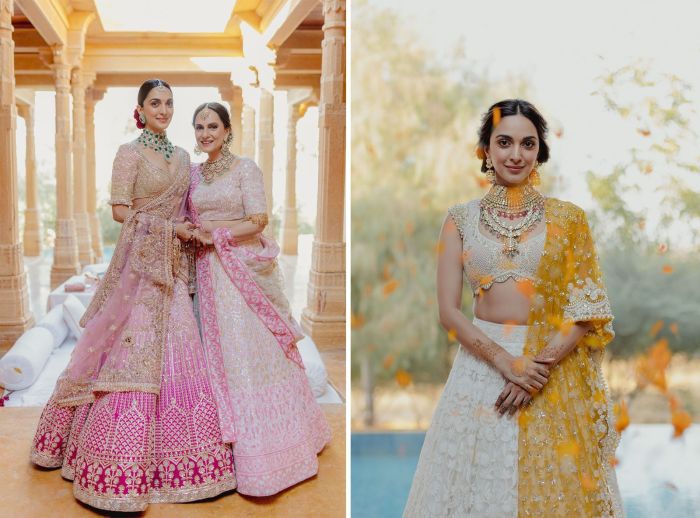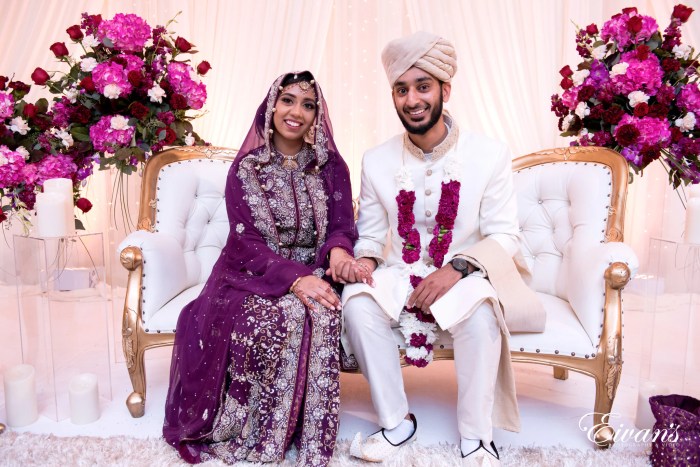Traditional Indian Wedding Attire
Indian wedding dresses for bride and groom – Indian wedding attire is a vibrant tapestry woven from centuries of tradition and evolving trends. The choice of clothing varies significantly across India’s diverse regions, reflecting unique cultural identities and artistic expressions. Understanding these regional differences, the symbolism embedded within the garments, and their historical evolution provides a richer appreciation for the significance of attire in Indian weddings.
Regional Variations in Bridal Attire
Bridal and groom’s attire showcase the rich diversity of Indian culture. The following table highlights some key regional distinctions:
| Region | Bridal Dress | Groom’s Dress | Notable Features |
|---|---|---|---|
| South India (e.g., Tamil Nadu, Kerala) | Kanjeevaram silk saree, Kasavu saree | Dhoti, Kurta, and sometimes a silk veshti | Rich, vibrant colors; intricate gold zari work; traditional temple jewelry |
| North India (e.g., Punjab, Rajasthan) | Lehenga choli, Anarkali suit | Sherwani, Achkan, Jodhpuri suit | Elaborate embroidery, heavy embellishments, bright hues; often includes heavy jewelry |
| West India (e.g., Gujarat, Maharashtra) | Paithani saree, Nauvari saree | Dhoti kurta, sometimes a kediyu | Unique weaving techniques; subtle yet elegant designs; often features traditional jewelry |
| East India (e.g., Bengal, Odisha) | Banarasi saree, Baluchari saree | Dhoti kurta, Panjabi | Silk fabrics; intricate weaving patterns; often adorned with traditional Bengali jewelry |
Symbolism and Significance of Colors
Color plays a crucial role in Indian wedding attire, carrying deep symbolic meaning. Red, for instance, traditionally represents purity, fertility, and good fortune, making it a popular choice for bridal wear. Other colors like yellow, orange, and green also hold significance, often representing prosperity, joy, and new beginnings. The selection of colors often reflects regional traditions and personal preferences.
Historical Evolution of Bridal and Groom’s Attire
Indian wedding attire has undergone a fascinating evolution. Traditional styles, often passed down through generations, have adapted to incorporate modern influences. For example, while sarees and dhotis remain staples, modern interpretations feature contemporary silhouettes, fabrics, and embellishments. The use of richer fabrics and more elaborate embroidery also increased over time, reflecting changing economic conditions and fashion trends.
Modern Trends in Indian Wedding Fashion
Contemporary Indian wedding fashion seamlessly blends tradition with modern aesthetics. While respecting heritage, designers are creating innovative styles that appeal to a modern sensibility.
Comparison of Traditional and Contemporary Styles, Indian wedding dresses for bride and groom
Traditional styles emphasize rich fabrics, intricate embroidery, and classic silhouettes. Modern styles retain these elements but often incorporate contemporary cuts, bolder color palettes, and unique embellishments. For instance, a modern bride might choose a lehenga with a contemporary asymmetrical hemline or a groom might opt for a slim-fit sherwani with subtle embroidery.
Emerging Trends in Fabrics, Embellishments, and Silhouettes
Modern Indian wedding fashion is marked by the use of luxurious fabrics like silk, velvet, and net, often combined with innovative embellishments. Three-dimensional embroidery, intricate sequin work, and delicate threadwork are popular choices. Silhouettes are becoming increasingly diverse, ranging from classic lehengas and sarees to contemporary gowns and jumpsuits. Sustainable and ethically sourced fabrics are also gaining popularity.
Three Modern Indian Bridal Looks
- Look 1: Modern Minimalist. A sleek, ivory silk saree with subtle embroidery paired with statement chandelier earrings and a loose, elegant bun. Makeup is natural and glowing, emphasizing the bride’s features.
- Look 2: Bold and Dramatic. A vibrant red lehenga with heavy gold embroidery and a dramatic, flowing dupatta. The jewelry is opulent, featuring a layered necklace, bangles, and a maang tikka. Makeup is bold and glamorous, with smoky eyes and a deep red lip.
- Look 3: Romantic and Ethereal. A pastel pink lehenga with delicate floral embroidery and a flowing silhouette. The jewelry is delicate and understated, featuring pearl earrings and a delicate necklace. Makeup is soft and romantic, with a focus on a dewy complexion and rosy cheeks.
The Role of Fabrics and Embellishments
The choice of fabric and embellishments significantly impacts the overall look and feel of Indian wedding attire. Luxurious fabrics and intricate detailing elevate the garments, reflecting the celebratory nature of the occasion.
Importance of Different Fabrics
Fabrics like silk, brocade, velvet, and net are commonly used due to their luxurious feel and drape. Silk, known for its sheen and smoothness, is a classic choice. Brocade adds texture and richness, while velvet offers a plush and opulent feel. Net is often used for creating lighter and more flowing garments.
Examples of Embellishments and Their Impact

Source: vogue.in
Zardozi, a form of metal embroidery, adds a regal touch. Intricate embroidery using threads of gold, silver, or silk creates stunning patterns. Stonework, using precious and semi-precious stones, adds sparkle and glamour. The choice of embellishment depends on the overall style and design of the garment.
Comparison of Fabric Properties and Suitability for Different Seasons
| Fabric | Properties | Suitable for |
|---|---|---|
| Silk | Smooth, lustrous, breathable (depending on weave) | Spring, Autumn, and mild summer climates |
| Brocade | Rich texture, heavy, less breathable | Winter or cooler climates |
| Velvet | Luxurious, warm, heavy | Winter |
| Net | Light, airy, sheer | Summer |
Accessories and Jewelry
Accessories and jewelry are integral to completing the bridal and groom’s look, adding a touch of elegance and tradition.
Traditional and Modern Indian Bridal Jewelry

Source: eivans.com
Traditional Indian bridal jewelry includes necklaces (layered necklaces, rani haar), earrings (jhumkas, studs), bangles (kadas, chura), and headpieces (maang tikka, passa). Modern interpretations incorporate contemporary designs while retaining traditional elements. For instance, brides might choose minimalist jewelry or incorporate unique gemstones.
How Jewelry Complements Attire
Jewelry choices should complement the bride’s and groom’s attire in terms of color, style, and embellishments. For example, a heavily embellished lehenga might be paired with statement jewelry, while a simpler saree might be complemented by delicate pieces.
Essential Accessories for Bride and Groom
- Bride: Jewelry (as described above), clutch, bridal shoes, dupatta (if applicable).
- Groom: Pocket square, cufflinks, shoes, turban (if applicable).
Styling and Photography: Indian Wedding Dresses For Bride And Groom
Hair, makeup, and photography play a crucial role in capturing the essence of Indian wedding attire.
Enhancing the Overall Look with Hairstyles and Makeup
Hairstyles should complement the overall style of the attire. Loose curls, braids, and updos are popular choices. Makeup should enhance the bride’s features without overpowering the attire. Natural, glowing makeup or bold, glamorous makeup can be chosen depending on the overall aesthetic.
Impact of Lighting and Setting on Wedding Photographs
Lighting and setting are crucial for capturing the beauty of Indian wedding attire. Natural light enhances the colors and textures of the garments. The choice of setting should complement the style of the attire; a traditional setting might be chosen for a classic look, while a modern setting might be chosen for a contemporary look.
Visual Description of a Wedding Photoshoot
Imagine a photoshoot at a majestic palace in Rajasthan. The bride is wearing a richly embellished red lehenga, complemented by traditional gold jewelry. The groom is in a cream-colored sherwani with intricate embroidery. The setting’s grandeur enhances the opulence of the attire, creating a timeless and elegant mood. The warm, golden light of the setting sun casts a magical glow, highlighting the intricate details of the garments and jewelry.
The overall mood is one of romance, celebration, and timeless elegance.
Budget Considerations and Ethical Sourcing
Planning a wedding involves careful consideration of budget and ethical sourcing.
Influence of Budget Constraints on Choices
Budget constraints can influence the choice of fabrics, embellishments, and designers. More affordable fabrics like cotton silk or chanderi can be used instead of pure silk. Simpler embellishments or fewer embellishments can be chosen. Selecting a less expensive designer or opting for rental options can also help manage costs.
Importance of Ethical Sourcing
Ethical sourcing ensures that fabrics and materials are produced sustainably and responsibly. This includes considering the environmental impact of production, fair labor practices, and the use of organic or recycled materials. Choosing designers committed to ethical practices supports responsible fashion.
Tips for Managing Wedding Attire Costs
To manage costs without compromising on quality or style, consider renting instead of buying, choosing a simpler design, or opting for pre-owned garments. Prioritize key elements, such as the bride’s main outfit, and consider less expensive options for other garments. Careful planning and budgeting are crucial.
User Queries
What are some common fabrics used in Indian wedding attire?
Silk, brocade, velvet, and banarasi are popular choices, each offering unique textures and draping qualities.
How far in advance should I start planning my wedding attire?
Ideally, begin at least 6-12 months before the wedding to allow ample time for design, tailoring, and alterations.
What is the significance of specific colors in Indian weddings?
Colors hold deep cultural and symbolic meaning, often varying by region and religion. Red is traditionally associated with good fortune and prosperity, while other colors may represent different auspicious connotations.
How can I find ethical and sustainable sources for my wedding attire?
Research designers and vendors committed to sustainable practices and responsible sourcing of materials. Look for certifications and transparency in their supply chains.
